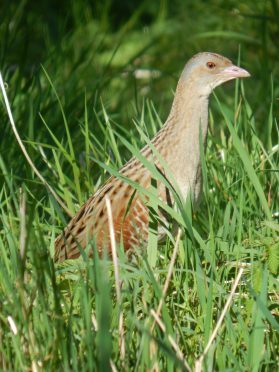Photographs of one of the country’s rarest birds feeding its mate have been captured by an RSPB Scotland officer on Tiree.
The corncrake, an extremely shy bird that is notoriously hard to spot or study, can be seen in the photos taking food to its mate in never-before recorded behaviour, and basking in the sunshine.
RSPB Scotland’s Dr John Bowler, who photographed the birds, said: “Corncrakes are very easy to hear, as anyone living on islands like Islay, Coll and Tiree will know right now. The males call loudly with a rasping sound throughout the night, but they’re usually very hard to see as they spend most of their time hiding in long grass and other vegetation.
“Tiree’s such a good home for them because of its low intensity beef-cattle production, with farmers and crofters carrying out a mowing pattern that’s specifically designed to be corncrake-friendly. The island is also amazing for breeding waders, like lapwings and redshanks, and a whole host of other wildlife, such as great yellow bumblebees.”
Because they’re so secretive, the corncrake population can only be reliably monitored by surveying for calling males, and this figure is currently around 1,200 for the whole of the UK. Of these birds, almost a third were recorded on Tiree.
Corncrakes have their first nests in late May, with a second nest in July, and some even attempt a third nest in good summers. Most only survive for one year, which is unusual for birds their size, and explains why they need to produce so many offspring each year to maintain their population.
Corncakes are only found in Scotland between April and October before migrating to Africa for the colder months. Birds from Coll were recently tracked to the Congo, where it’s thought they may spend their winters in forest clearings created by elephants.
